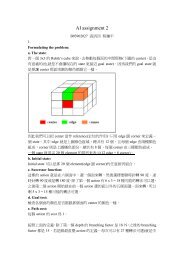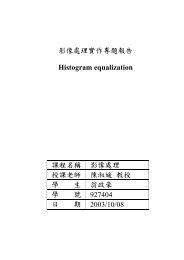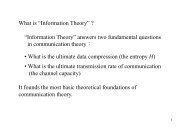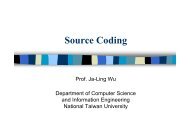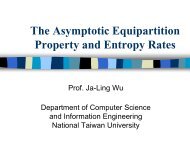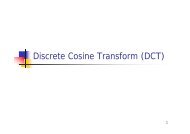Rate Distortion Function and Optimal Bit-Allocation
Rate Distortion Function and Optimal Bit-Allocation
Rate Distortion Function and Optimal Bit-Allocation
Create successful ePaper yourself
Turn your PDF publications into a flip-book with our unique Google optimized e-Paper software.
Recall:<br />
<strong>Rate</strong> <strong>Distortion</strong> <strong>Function</strong> <strong>and</strong><br />
<strong>Optimal</strong> <strong>Bit</strong>-<strong>Allocation</strong><br />
Information theory<br />
: the problem of source coding “what<br />
information should be sent”, <strong>and</strong> the<br />
problem of channel coding “how should it<br />
be sent”, can be separated without loss of<br />
optimality.<br />
1
Source coding theorem:<br />
: the entropy H(x) of a source x is the<br />
minimum rate at which a source can be<br />
encoded without information loss.<br />
2
Channel coding theorem:<br />
:for error-free transmission over a channel<br />
with capacity C, the rate of the source<br />
needs to be smaller or equal to C.<br />
3
The rate distortion function (RFD) R(D)<br />
: the lower bound on the rate necessary to<br />
represent a certain source with a given<br />
distortion. The RDF can be considered as<br />
an extension of the idea of entropy for the<br />
case when a certain distortion in the<br />
representation of the data is permissible.<br />
4
If a certain channel capacity c is given, the<br />
RDF can be used to find the necessary<br />
maximum average distortion D ave so that<br />
the condition for error-free transmission<br />
R(D ave) < c is achieved. Conversely the<br />
RDF can also be used to find the minimum<br />
capacity necessary to transmit a certain<br />
source with a given average distortion.<br />
5
Source {x i,p(x i)}<br />
Channel : Q(y j | x i)<br />
The marginal probability of the received<br />
message set is<br />
∑<br />
T (<br />
Yi<br />
) = p(<br />
x j ) Q(<br />
yi<br />
| x j )<br />
j<br />
6
The average mutual information for a<br />
block length N, I N(x,y) is defined as<br />
I N ( x,<br />
y)<br />
= ∑∑<br />
=<br />
E<br />
i j<br />
x,<br />
y<br />
p(<br />
x<br />
i<br />
⎡ ⎛<br />
⎢log⎜<br />
⎢<br />
⎜<br />
⎣ ⎝ T<br />
) Q(<br />
y<br />
1<br />
( y<br />
j<br />
)<br />
j<br />
|<br />
x<br />
i<br />
Q(<br />
y j |<br />
) log<br />
T ( y<br />
⎞ ⎛<br />
⎟<br />
1<br />
− log⎜<br />
⎟ ⎜<br />
⎠ ⎝ Q(<br />
y j | x<br />
j<br />
i<br />
x<br />
)<br />
i<br />
)<br />
⎞⎤<br />
⎟⎥,<br />
) ⎟<br />
⎠⎥⎦<br />
Where Ex,y[.] is the expectation operator w.r.t.<br />
x <strong>and</strong> y.<br />
7
Mutual information between x,y is the<br />
expectation value of the difference<br />
between the self information gained by<br />
observing a message y j at the sink <strong>and</strong> the<br />
information gained by observing a<br />
message y j at the sink given that we know<br />
that message x i was sent.<br />
8
Error-free transmission knowing x i<br />
implies knowing y j y=x <strong>and</strong> T(y i) = P(x i)<br />
The information transmitted is equal to the<br />
average information of y, which is called<br />
the N-th-order entropy of y, i.e.,<br />
∑ ⎟ ⎛ 1 ⎞<br />
I = = =<br />
⎜<br />
N (<br />
x,<br />
y)<br />
H N ( x)<br />
H N ( y)<br />
p(<br />
xi<br />
) log<br />
Error−<br />
free<br />
i ⎝ p(<br />
xi<br />
) ⎠<br />
<strong>Optimal</strong> error-free coding requires at least<br />
H N(x) bits.<br />
9
I N<br />
N<br />
N<br />
( x,<br />
y)<br />
= H ( x)<br />
− H ( x | y)<br />
Both I N ( ⋅,<br />
⋅)<br />
<strong>and</strong> H<br />
(⋅)<br />
are non-negative<br />
quantities,<br />
I N<br />
N<br />
( x,<br />
y)<br />
≤ H ( x)<br />
:No information can be added by the<br />
encoding stage.<br />
10
Let d(x,y) be the distortion between x <strong>and</strong><br />
y. The expected distortion for a given<br />
channel Q is:<br />
1<br />
D( Q)<br />
= Ex,<br />
y[<br />
d(<br />
x,<br />
y)]<br />
N<br />
1<br />
= ∑∑ p(<br />
xi<br />
) Q(<br />
y j | xi<br />
) d(<br />
xi,<br />
y j )<br />
N<br />
i j<br />
11
The N-blocks RDF (R N(D *)) is the<br />
minimum of the average mutual<br />
information per symbol, for D(Q) less than<br />
some value D *, that is,<br />
1<br />
RN ( D*<br />
) =<br />
inf I N ( x,<br />
y)<br />
Q:<br />
D(<br />
Q)<br />
≤D*<br />
N<br />
12
The RDF is obtained by taking the limit as<br />
the block length N goes to infinity,<br />
RN N<br />
N →∞<br />
( D*<br />
) =<br />
lim R ( D*<br />
)<br />
13
The RDF is the limit as the block size goes<br />
to infinity of the average mutual<br />
information per source symbol, subject to<br />
the constraint that the average distortion is<br />
less than D * , where the minimization is<br />
performed overall encoding scheme as<br />
described by the conditional probability<br />
assignment Q(<br />
⋅ | ⋅)<br />
Characteristics of RDF : continuous,<br />
convex, differentiable <strong>and</strong> non-increasing.<br />
14
• The channel capacity is defined by<br />
1<br />
c =<br />
lim sup I N ( U,<br />
V )<br />
N →∞<br />
w N<br />
Where U is the channel input <strong>and</strong> V is the<br />
channel output <strong>and</strong> W(V j|U i) is the<br />
conditional probability assignment which<br />
describes the channel mathematically<br />
15
Source coding theorem for a describe<br />
source with a fidelity criterion:<br />
When distortion is permissible, states that<br />
if c >R(D *) then, by using large enough<br />
blocks (VQ-based), a source can be sent<br />
over a channel with capacity c with an<br />
average distortion less than or equal to D * .<br />
16
The converse of this theorem is also true:<br />
If c < R(D *) then it is impossible to send<br />
that source over a channel with capacity c<br />
having an average distortion less than or<br />
equal to D * .<br />
17
Remarks : The power of RDF stem from<br />
the fact that absolute bounds can be found<br />
on the performance of a lossy data<br />
compression scheme. Unfortunately, most<br />
of the proofs are existence proofs, which<br />
means that they prove there exist a bound,<br />
but they do not provide a mechanism for<br />
constructing a scheme which achieves this<br />
bound.<br />
18
Operational <strong>Rate</strong> <strong>Distortion</strong> Theory : (ORDT)<br />
ORDT is based on the fact that every<br />
lossy data compression scheme has only<br />
a finite set of admissible quantizers.<br />
– There is only a finite number of<br />
possible rate distortion pairs for any<br />
given source. These pairs form the<br />
quantizer function (QF).<br />
19
Let Q = {q 0,…,q M-1) be the set of all<br />
admissible quantizer. Let R(q i) be the rate<br />
for a particular quantizer <strong>and</strong> a particular<br />
source <strong>and</strong> D(q i) the corresponding<br />
distortion. Then,<br />
QF<br />
=<br />
{ ( ) } 1 M −<br />
R(<br />
q ), D(<br />
q )<br />
i<br />
i<br />
i=<br />
0<br />
20
The quantizers which result in the ORDF<br />
be defined as follows:<br />
Q ORDF<br />
{ q : q ∈Q,<br />
R(<br />
q)<br />
≥ R(<br />
p)<br />
⇒ D(<br />
q)<br />
< D(<br />
p ∀p<br />
∈Q}<br />
= ),<br />
which is equivalent to the following<br />
definitions:<br />
(Operational <strong>Rate</strong> <strong>Distortion</strong> <strong>Function</strong>)<br />
21
Q ORDF<br />
{ q :<br />
q ∈Q,<br />
D(<br />
q)<br />
≥ D(<br />
p)<br />
⇒ R(<br />
q)<br />
< R(<br />
p ∀p<br />
∈Q}<br />
= ),<br />
: a quantizer can only belong to Q ORDF if<br />
there is no other quantizer which results in<br />
a lower or equal rate <strong>and</strong> a lower distortion<br />
or equivalently, there is no other quantizer<br />
which results in a smaller distortion using<br />
the same or a smaller rate.<br />
22
We relabel the quantizer in Q ORDF from<br />
zero to | Q ORDF |-1 such that<br />
D(q i) < D(q i+1), which by definition of Q ORDF<br />
implies that R(q i) > R(q i+1)<br />
The ORDF is defined as the following<br />
ordered set or rate distortion points.<br />
ORDF<br />
=<br />
{ ( ) } | QORDF<br />
| −1<br />
R(<br />
q ), D(<br />
q )<br />
i<br />
i<br />
i=<br />
0<br />
23
Remarks:<br />
1. The idea of ORDT is to analyze a given<br />
compression scheme <strong>and</strong> to find its theoretical<br />
optimal performance, whereas RDT tries to<br />
find the absolute performance bound w.r.t. any<br />
scheme.<br />
2. RDT is useful in assessing how close the<br />
performance of an actual scheme comes to the<br />
theoretical optimal, ORDT can be used to<br />
optimize the actual scheme to perform at its<br />
best.<br />
– ORDT is closely related to optimal bit<br />
allocation.<br />
24
ate<br />
convex<br />
hull<br />
rate distortion<br />
function<br />
+<br />
+<br />
+<br />
+<br />
+ + +<br />
operational rate<br />
distortion function<br />
+<br />
+<br />
+<br />
+ +<br />
+, :rate-distortion pairs<br />
+<br />
+<br />
+<br />
+<br />
+<br />
distortion<br />
25
<strong>Optimal</strong> <strong>Bit</strong> <strong>Allocation</strong>:<br />
: to distribute the available bit budget<br />
among different sources of information<br />
such that the resulting overall distortion<br />
is minimized.<br />
Remarks:<br />
1. Independent v.s. dependent quantizers.<br />
2. MINAVE v.s. MINMAX<br />
3. Real Number v.s. Integer<br />
4. Model-based (RDF) v.s. O.R.D.F.<br />
26
References:<br />
1. “<strong>Bit</strong> <strong>Allocation</strong> for dependent quantization<br />
with applications to multiresolution <strong>and</strong><br />
MPEG video coders,” IEEE Trans. on<br />
Image Processing, pp.533-545, Sept.<br />
1994.<br />
2. “<strong>Rate</strong>-distortion optimal (fast thresholding<br />
with complete JPEG/MPEG decoder<br />
compatibility, IEEE Trans. on Image<br />
Processing, pp. 700-704, Sept. 94<br />
27
A Simple Algorithm:<br />
One starts by giving zero bits to each<br />
source <strong>and</strong> then allocates enough bits to<br />
the source with the highest distortion so<br />
that its distortion is reduced by the<br />
smallest amount possible, using the QF of<br />
that source. Then the source with the<br />
largest distortion is found <strong>and</strong> again bits<br />
are allocated to that source until its<br />
distortion drops. This is repeated until all<br />
bits are used up.<br />
28
Lagrangian Multiplier Method:<br />
Theorem 1:<br />
Let SB be a finite set <strong>and</strong> B ∈SB<br />
be a<br />
member of that set. Let R(B) <strong>and</strong> D(B) be<br />
real valued functions defined over SB. Then, for any λ ≥ 0 the optimal solution<br />
B*<br />
( λ)<br />
to the unconstrained problem,<br />
min( D(<br />
B)<br />
+ λR(<br />
B))<br />
B∈S<br />
B<br />
29
is also an optimal solution to the<br />
constrained problem,<br />
min( D(<br />
B))<br />
B∈S<br />
B<br />
subject to :<br />
R( B)<br />
≤<br />
R(<br />
B*<br />
( λ))<br />
30
Proof. (by contradiction):<br />
Assume that the above theorem is false.<br />
There exists a B ∈ SB such that<br />
D ( B)<br />
< D(<br />
B*<br />
( λ))<br />
<strong>and</strong> R( B)<br />
≤ R(<br />
B*<br />
( λ)).<br />
D( B)<br />
+ λ ⋅ R(<br />
B)<br />
< D(<br />
B*<br />
( λ))<br />
+ λ ⋅ R(<br />
B*<br />
( λ)),<br />
which is a contradiction since<br />
B*<br />
( λ)<br />
is the optimal solution to the<br />
unconstrained problem.<br />
31
Remark:<br />
Theorem 1 does not guarantee a solution to the<br />
constrained problem. All it says is that to every<br />
non-negative λ , there exists a corresponding<br />
constrained problem whose solution is identical<br />
to that of the unconstrained problem.<br />
That is:<br />
If R(<br />
B*<br />
( λ))<br />
happens to be equal to an upper<br />
bound Rmax, B*<br />
( λ)<br />
is the desired solution to<br />
the constrained problem. A problem remains<br />
to be solved is how to find a<br />
λ<br />
∋ R ( B*<br />
( λ))<br />
= R max<br />
32
Theorem 2: If R B * ( λ )) > R(<br />
B*<br />
( λ )) then<br />
( 1<br />
2<br />
λ-theorem<br />
D(<br />
B*<br />
( λ1))<br />
− D(<br />
B*<br />
( λ2))<br />
λ2 ≥ −<br />
≥<br />
R(<br />
B*<br />
( λ1))<br />
− R(<br />
B*<br />
( λ2))<br />
Proof:<br />
By the optimality of B*<br />
( λ1)<br />
, the<br />
following holds,<br />
D B*<br />
( λ )) + λ ⋅ R(<br />
B(<br />
λ )) ≤ D(<br />
B*<br />
( λ )) + λ ⋅ R(<br />
B*<br />
( λ ))<br />
( 1 1<br />
1<br />
2 1<br />
2<br />
Solving for λ1<br />
, <strong>and</strong> keeping in mind that<br />
R B*<br />
( λ ) > R(<br />
B*<br />
( λ )),<br />
( 1<br />
2<br />
−<br />
D(<br />
B*<br />
( λ1))<br />
R(<br />
B*<br />
( λ ))<br />
1<br />
−<br />
−<br />
D(<br />
B*<br />
( λ2))<br />
R(<br />
B*<br />
( λ ))<br />
2<br />
λ<br />
1<br />
≥ λ<br />
1<br />
33
Similarly, we can prove<br />
λ ≥<br />
−<br />
2<br />
D(<br />
B*<br />
( λ1))<br />
R(<br />
B*<br />
( λ ))<br />
1<br />
−<br />
−<br />
D(<br />
B*<br />
( λ2))<br />
R(<br />
B*<br />
( λ ))<br />
The λ-theorem states that given two<br />
optimal solutions, the ratio of the change<br />
in optimal distortion to the change in the<br />
required rate is bounded between the two<br />
multipliers.<br />
2<br />
34
If the set of solutions produced by Lagrangian multipliers<br />
results in a distortion that is a differentiable function of<br />
the rate at some point, then fromλ-theorem,<br />
λat that point is the derivative of the distortion w.r.t. the<br />
rate<br />
<br />
dD<br />
−<br />
dR<br />
= λ<br />
By applying this results to the ORDF<br />
(assuming the derivative exists)<br />
assumptions!!<br />
dR<br />
1<br />
= −<br />
dD λ<br />
: fast convex search for the optimal λ<br />
35
Iterative Search forλ<br />
Theorem 3:<br />
proof:<br />
( B*<br />
( λ))<br />
is a non-increasing function of<br />
the Lagrangian multiplier λ<br />
R<br />
Let λ2<br />
> λ1<br />
> 0 <strong>and</strong> assume that<br />
R ( B*<br />
( λ2)) > R(<br />
B*<br />
( λ1))<br />
. Then from the λtheorem<br />
it follows that λ1 ≥ λ2<br />
, which is a<br />
contradiction. That is, R B*<br />
( λ )) <<br />
R(<br />
B*<br />
( λ<br />
( 2<br />
1<br />
36<br />
))
Corollary 1: D(<br />
B*<br />
( λ))<br />
is a non-decreasing<br />
function of λ.<br />
Since R(<br />
B*<br />
( λ))<br />
is a non-increasing function<br />
of λ, the bisection method can be used to<br />
find the optimal λ.<br />
37
Start:<br />
two initial guesses for λ , λl <strong>and</strong> λu<br />
which<br />
have to be selected ∋ R( B*<br />
( λl )) ≥ R max ≥ , R(<br />
B*<br />
( λu<br />
where Rmax is maximum number of bits<br />
available i.e., the target bitrate.<br />
Since R(<br />
B*<br />
( λ))<br />
is non-increasing, the<br />
desired λ (if it exists) lies between λl <strong>and</strong> λu.<br />
λl<br />
+ λu<br />
By selecting λm<br />
=<br />
2 , the initial interval<br />
is bisected. Then R( B*<br />
( λm))<br />
is evaluated,<br />
<strong>and</strong> if R( B*<br />
( m)) R max then ,<br />
otherwise<br />
≥ λ λ l = λm<br />
λ =<br />
λ<br />
u<br />
m<br />
))<br />
38
By repeating this procedure, tighter <strong>and</strong><br />
tighter bounds for the requiredλare found.<br />
As mentioned before, there might not beλ<br />
which satisfies R ( B*<br />
( λ))<br />
= R max exactly.<br />
Since R is defined on the finite set SB. Therefore, the bisection is stopped when a<br />
solution is found which satisfies<br />
R max− E ≤ R(<br />
B*<br />
( λ))<br />
≤ R max+<br />
E<br />
where E<br />
≥ 0<br />
39
( ( ))<br />
*<br />
R B λ<br />
Rmax<br />
( ( ))<br />
*<br />
R B λ<br />
l<br />
m<br />
( ( ))<br />
*<br />
R B λ<br />
( ( ))<br />
* R B λ<br />
u<br />
λl λc λm λu<br />
λ<br />
40
R<br />
R<br />
( *<br />
R(B)<br />
B1<br />
( λ))<br />
( *<br />
B2<br />
( λ))<br />
+<br />
+<br />
+<br />
+<br />
+<br />
+<br />
+<br />
+<br />
convex hull<br />
+<br />
+<br />
( ( ))<br />
*<br />
D B1<br />
λ ( ( ))<br />
*<br />
D B2<br />
λ<br />
+<br />
Operational rate distortion curve<br />
+<br />
+<br />
+<br />
+<br />
+ +<br />
D(B)<br />
1 ⎧ * −1<br />
* ⎫<br />
R(<br />
B)<br />
= − D(<br />
B)<br />
+ ⎨R(<br />
B ( λ))<br />
+ D(<br />
B ( λ))<br />
⎬<br />
λ ⎩ λ ⎭<br />
Note that not all circles belong to the convex hull. These points are inaccessible<br />
for the Lagrangian multiplier method.<br />
41
Convex Hull Solutions:<br />
RDF is a non-increasing convex function.<br />
ORDF is a set of points in the rate<br />
distortion space. When the points of<br />
ORDF are connected by straight lines, the<br />
resulting curve is not necessarily convex.<br />
In the following, we show that the<br />
Lagrangian multiplier method can only be<br />
used to find the points of the ORDF which<br />
belong to the convex hull of the ORDF.<br />
42
B*<br />
( λ)<br />
min( D(<br />
B)<br />
+ λR(<br />
B)).<br />
Assume that is an optimal solution to<br />
B∈S<br />
B<br />
This implies the following,<br />
D( B*<br />
( λ))<br />
+ λ ⋅ R(<br />
B*<br />
( λ))<br />
≤ D(<br />
B)<br />
+ λ ⋅ R(<br />
B)<br />
Where B ∈ SB<br />
can be any admissible decision<br />
vector.<br />
By rearranging terms, one can obtain<br />
1 ⎧<br />
1 ⎫<br />
R ( B)<br />
≥ − D(<br />
B)<br />
+ ⎨R(<br />
B*<br />
( λ))<br />
+ D(<br />
B*<br />
( λ))<br />
⎬<br />
λ ⎩ λ ⎭<br />
...(Δ)<br />
43
Consider the case when the equal sign in (Δ)<br />
holds.<br />
Eqn. (Δ)<br />
defines a line in the rate distortion space<br />
(plane).<br />
Eqn. (Δ)<br />
States that all points (D(B),R(B)) of the<br />
QF must lie in the upper right half-plane of the<br />
rate distortion plane, i.e., above the line defined<br />
by eqn. (Δ)<br />
, whereas the set of optimal solution<br />
{ *<br />
*<br />
( D(<br />
B<br />
}<br />
i ( λ)), R(<br />
Bi<br />
( λ))<br />
is on the line.<br />
1<br />
Recall that the slope of the line equals −<br />
λ , the<br />
rate R(<br />
B*<br />
( λ))<br />
is a non-increasing function ofλ<br />
<strong>and</strong> the distortion D(<br />
B*<br />
( λ))<br />
is a non-decreasing<br />
function of λ.<br />
44
If we sweepλ from zero to infinity, <strong>and</strong><br />
connect the points ( D(<br />
B*<br />
( λ)), R(<br />
B*<br />
( λ)))<br />
by<br />
straight lines, the convex hull of the ORDF<br />
is generated.<br />
A point of the ORDF which is not the<br />
convex hull can not be found using a<br />
Lagrangian approach since one cannot<br />
find a line (<strong>and</strong> hence aλ) which partitions<br />
the plane such that all solutions belong to<br />
the resulting upper right half-plane.<br />
45
For the Lagrangian multiplier method to work,<br />
the only requirement is that the optimal solution<br />
of the relaxed (unconstrained) problem can be<br />
found.<br />
It is important to notice that the role of the rate<br />
<strong>and</strong> the distortion can be interchanged <strong>and</strong> the<br />
presented theory still applies. In other words, the<br />
following problem,<br />
min R(<br />
B)<br />
subject to: D( B)<br />
≤<br />
D max<br />
B∈S<br />
B<br />
can also be solved by the Lagrangian multiplier<br />
method.<br />
46





